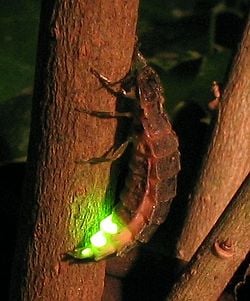Firefly
| Fireflies | ||||||||||||||||
|---|---|---|---|---|---|---|---|---|---|---|---|---|---|---|---|---|
 Lampyris noctiluca
| ||||||||||||||||
| Scientific classification | ||||||||||||||||
| ||||||||||||||||
|
Curtos |
Fireflies ( family Lampyridae), also called lightning bugs, are luminous beetles. These names come from the fact that the adults of some species as emit flashes of light to attract mates for sexual reproduction, using special light-emitting organs in the abdomen.
There are more than 2000 species of firefly, found in temperate and tropical environments around the world. Most fireflies in the United States are found east of the Rocky Mountains.
Biology
Fireflies tend to be soft-bodied, often with the elytra more leathery than in other beetles. They are small to medium sized, and some are colourful. Though the females of some species are similar in appearance to males, larviform females are found in many other firefly species. These females can often only be distinguished from the larvae because they have compound eyes.
The most commonly known fireflies are nocturnal, though there are numerous species that are diurnal. Most diurnal species are non-luminescent, though some day-flying species that remain in shadowy areas, such as Lucidota spp., do produce light.
A few days after mating, which occurs in the spring, a female lays her fertilized eggs on or just below the surface of the ground. The eggs hatch 3-4 weeks later and the larva feed until the end of the summer. The larvae are commonly called glowworms, not to be confused with the distinct beetle family Phengodidae. Lampyrid larvae have simple eyes.
Fireflies overwinter (some species for several years) during the larval stage. Some do this by burrowing underground, while others find places on or under the bark of trees. They emerge in the spring. After several weeks of feeding, they pupate for 1 to 2.5 weeks and emerge as adults.
The larvae of most species are specialized predators and feed on other larvae, terrestrial snails, and slugs. Some are so specialized that they have grooved mandibles, which deliver digestive fluids directly to their prey. The diet of adults is variable. It has been reported that some are predatory and some feed on plant pollen or nectar.
Light production
The process of light production in fireflies is called bioluminescence.
Many species, especially in the genus Photinus, are distinguished by the unique courtship flash patterns emitted by flying males as they search for females. Photinus females generally do not fly, but give a flash response to males of their own species. Female Photuris fireflies are known for mimicking the mating flashes of other fireflies for the sole purpose of predation[1].
Tropical fireflies, particularly in Southeast Asia (Thailand and Malaysia) routinely synchronize their flashes among large groups, a startling example of spontaneous biological order. This phenomenon occurs through the night along river banks in the Malaysian jungles every day of the year. It is significantly more rare in the Western hemisphere. Current hypotheses about the causes range from diet, social interaction and altitude. In the United States, one of the most famous sightings of fireflies blinking in unison occur near Elkmont, Tennessee in the Great Smoky Mountains during the second week of June[2]. Congaree National Park in South Carolina is host to the phenomenon at points at or above 2,000 feet in elevation[3][4].
Some fireflies do not glow as adults, but all glow as larvae. Bioluminescence serves a different function in lampyrid larvae than it does in adults. It appears to be a warning signal to predators, since many firefly larvae contain chemicals that are distasteful or toxic.
Light production in fireflies is due to a chemical reaction that occurs in specialized light organs, usually on the lower abdomen. The enzyme luciferase acts on the substrate luciferin to stimulate light emission. This reaction is of scientific interest, and genes coding for these substances have been spliced into many different organisms.
Fireflies and humans
The ancient Chinese sometimes captured fireflies in transparent or semi-transparent containers and used them as (short-term) lanterns.
The firefly is the state insect of Pennsylvania. At one point, Indiana seriously considered making the Say's Firefly the state insect, but the legislature never put the measure to a vote.
ReferencesISBN links support NWE through referral fees
- Lampyridae (TSN 113835). Integrated Taxonomic Information System. Accessed on 30 April 2006.
- http://www.ncbi.nlm.nih.gov/Taxonomy/Browser/wwwtax.cgi
- http://www.iisc.ernet.in/academy/resonance/Sept2002/pdf/Sept2002p49-55.pdf
- Branham, M. A., and J. W. Wenzel. 2003. The origin of photic behavior and the evolution of sexual communication in fireflies (Coleoptera: Lampyridae). Cladistics 19: 1-22.
External links
- Facts about Lampyridae
- Firefly sighting reports
- Nitric oxide and Firefly Flashing has a detailed molecular description.
- Lightning bugs
- Afterglow - Is it lights out for fireflies? (Failure magazine, June 2003)
Credits
New World Encyclopedia writers and editors rewrote and completed the Wikipedia article in accordance with New World Encyclopedia standards. This article abides by terms of the Creative Commons CC-by-sa 3.0 License (CC-by-sa), which may be used and disseminated with proper attribution. Credit is due under the terms of this license that can reference both the New World Encyclopedia contributors and the selfless volunteer contributors of the Wikimedia Foundation. To cite this article click here for a list of acceptable citing formats.The history of earlier contributions by wikipedians is accessible to researchers here:
The history of this article since it was imported to New World Encyclopedia:
Note: Some restrictions may apply to use of individual images which are separately licensed.


